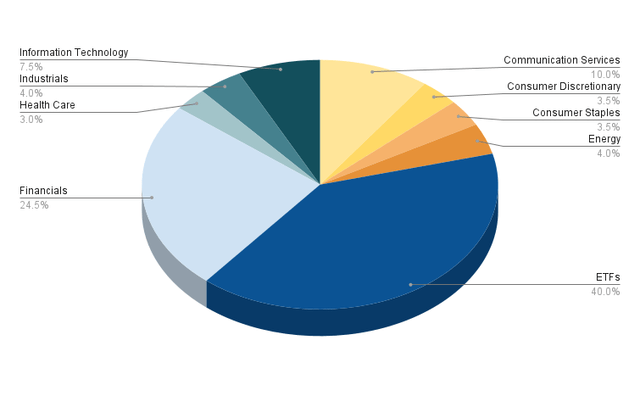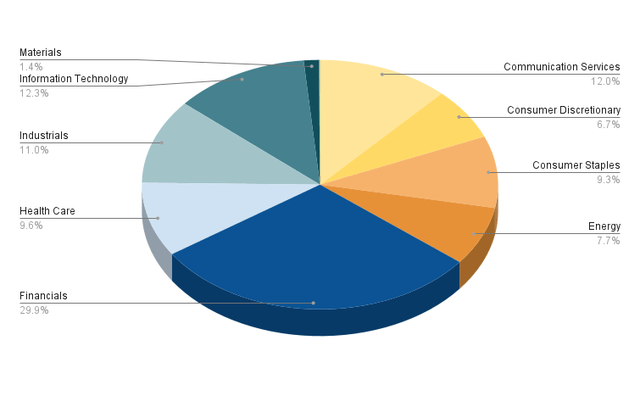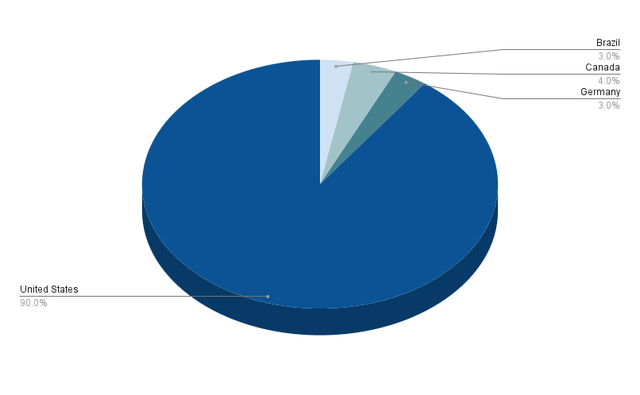Investment Thesis
A dividend income oriented investment portfolio brings you the benefits of earning an extra income via dividend payments without the need to sell positions from your investment portfolio to obtain capital gains.
The aim of this article is to show you how to build such a portfolio using my top 30 stocks of the month of June. The portfolio is made up of high dividend yield companies, dividend growth companies and growth companies.
I have constructed this portfolio in a way so that it provides you with an attractive Weighted Average Dividend Yield [TTM] of 3.58%, which indicates that it can help you earn a significant amount of extra income via dividend payments.
In addition to that, it can be highlighted that the selected picks have shown a Weighted Average Dividend Growth Rate [CAGR] of 11.05% over the past 5 years, indicating that the portfolio should also provide you with significant Dividend Growth in the years ahead.
The following are my top 10 high dividend yield companies for June 2023:
- Allianz (OTCPK:ALIZF, OTCPK:ALIZY)
- Altria (NYSE:MO)
- AT&T (NYSE:T)
- BB Seguridade Participações (OTCPK:BBSEY)
- Johnson & Johnson (JNJ)
- Kinder Morgan (KMI)
- The Bank of Nova Scotia (BNS)
- United Parcel Service (UPS)
- U.S. Bancorp (USB)
- Verizon Communications Inc. (VZ)
Here are my top 10 dividend growth companies for June 2023:
- Apple (NASDAQ:AAPL)
- BlackRock (NYSE:BLK)
- Canadian Natural Resources Limited (NYSE:CNQ)
- Goldman Sachs (NYSE:GS)
- JPMorgan (NYSE:JPM)
- Mastercard (NYSE:MA)
- Microsoft (NASDAQ:MSFT)
- Nasdaq (NASDAQ:NDAQ)
- The Charles Schwab Corporation (NYSE:SCHW)
- Union Pacific Corporation (NYSE:UNP)
And these are my top 10 growth companies for June 2023:
- Adobe (ADBE)
- Alphabet (GOOG, GOOGL)
- Amazon (AMZN)
- Palo Alto Networks (PANW)
- PayPal (NASDAQ:PYPL)
- Salesforce (CRM)
- T-Mobile (TMUS)
- Tesla (TSLA)
- The Trade Desk (TTD)
- XP (XP)
Overview of the 30 selected Picks for June 2023, the selected ETF, and the Portfolio Allocation
|
Company Name |
Sector |
Industry |
Country |
Dividend Yield [TTM] |
Div Growth 5Y |
Allocation |
Amount in $ |
|
Adobe |
Information Technology |
Application Software |
United States |
0% |
0.00% |
1.5% |
375.00 |
|
Allianz |
Financials |
Multi-line Insurance |
Germany |
5.45% |
5.72% |
3.0% |
750.00 |
|
Alphabet |
Communication Services |
Interactive Media and Services |
United States |
0% |
0.00% |
2.0% |
500.00 |
|
Altria |
Consumer Staples |
Tobacco |
United States |
8.21% |
7.18% |
3.5% |
875.00 |
|
Amazon |
Consumer Discretionary |
Broadline Retail |
United States |
0% |
0.00% |
2.0% |
500.00 |
|
Apple |
Information Technology |
Technology Hardware, Storage and Peripherals |
United States |
0.54% |
7.26% |
2% |
500.00 |
|
AT&T |
Communication Services |
Integrated Telecommunication Services |
United States |
6.81% |
-5.78% |
3.0% |
750.00 |
|
BB Seguridade Participações S.A. |
Financials |
Multi-line Insurance |
Brazil |
9.19% |
13.89% |
2.0% |
500.00 |
|
BlackRock |
Financials |
Asset Management and Custody Banks |
United States |
2.97% |
13.60% |
3% |
750.00 |
|
Canadian Natural Resources Limited |
Energy |
Oil and Gas Exploration and Production |
Canada |
4.12% |
21.83% |
2% |
500.00 |
|
Johnson & Johnson |
Health Care |
Pharmaceuticals |
United States |
2.84% |
6.11% |
3.0% |
750.00 |
|
JPMorgan Chase & Co. |
Financials |
Diversified Banks |
United States |
2.93% |
12.91% |
3% |
750.00 |
|
Kinder Morgan |
Energy |
Oil and Gas Storage and Transportation |
United States |
6.75% |
14.16% |
2.0% |
500.00 |
|
Mastercard |
Financials |
Transaction & Payment Processing Services |
United States |
0.57% |
17.66% |
2% |
500.00 |
|
Microsoft |
Information Technology |
Systems Software |
United States |
0.84% |
10.02% |
2% |
500.00 |
|
Nasdaq |
Financials |
Financial Exchanges and Data |
United States |
1.47% |
9.57% |
1% |
250.00 |
|
Palo Alto Networks |
Information Technology |
Systems Software |
United States |
0% |
0.00% |
1.0% |
250.00 |
|
PayPal |
Financials |
Transaction & Payment Processing Services |
United States |
0% |
0.00% |
1.5% |
375.00 |
|
Salesforce |
Information Technology |
Application Software |
United States |
0% |
0.00% |
1.00% |
250.00 |
|
Schwab U.S. Dividend Equity ETF |
ETFs |
ETFs |
United States |
3.75% |
15.56% |
40.0% |
10,000.00 |
|
T-Mobile |
Communication Services |
Wireless Telecommunication Services |
United States |
0% |
0.00% |
1.0% |
250.00 |
|
Tesla |
Consumer Discretionary |
Automobile Manufacturers |
United States |
0% |
0.00% |
1.5% |
375.00 |
|
The Bank of Nova Scotia |
Financials |
Diversified Banks |
Canada |
6.24% |
4.38% |
2.0% |
500.00 |
|
The Charles Schwab Corporation |
Financials |
Investment Banking and Brokerage |
United States |
1.78% |
21.16% |
1% |
250.00 |
|
The Goldman Sachs Group |
Financials |
Investment Banking and Brokerage |
United States |
2.94% |
25.93% |
3% |
750.00 |
|
The Trade Desk |
Communication Services |
Advertising |
United States |
0% |
0.00% |
1.0% |
250.00 |
|
U.S. Bancorp |
Financials |
Diversified Banks |
United States |
6.31% |
10.00% |
2.0% |
500.00 |
|
Union Pacific Corporation |
Industrials |
Rail Transportation |
United States |
2.65% |
14.83% |
1% |
250.00 |
|
United Parcel Service |
Industrials |
Air Freight and Logistics |
United States |
3.67% |
12.53% |
3.0% |
750.00 |
|
Verizon Communications |
Communication Services |
Integrated Telecommunication Services |
United States |
7.21% |
2.04% |
3.0% |
750.00 |
|
XP |
Financials |
Investment Banking and Brokerage |
Brazil |
0% |
0.00% |
1.0% |
250.00 |
|
3.58% |
11.05% |
100% |
25000 |
Source: The Author
Portfolio Allocation per Company/ETF
The Schwab U.S. Dividend Equity ETF (NYSEARCA:SCHD) has the highest percentage of the overall investment portfolio (40%). This helps us to reach a broad diversification over sectors and industries as well as to increase the Weighted Average Dividend Yield and Weighted Average Dividend Growth Rate of this portfolio.
The following companies represent the largest individual positions of the investment portfolio:
- Altria (3.5%)
- Allianz (3%)
- AT&T (3%)
- BlackRock (3%)
- Johnson & Johnson (3%)
- JPMorgan (3%)
- The Goldman Sachs Group (3%)
- United Parcel Service (3%)
- Verizon (3%)
I have selected these companies to have the highest percentage as I believe that each of them is an attractive pick in terms of risk and reward (I consider the risk level to be relatively low while considering the expected compound annual rate of return to be relatively high).
In addition to that, each of these picks provides investors with an attractive Dividend Yield and they can therefore help your portfolio to enhance its Weighted Average Dividend Yield. Moreover, I believe that each of them can contribute to providing your portfolio with Dividend Growth, thus helping you increase your annual income in the form of dividends from year to year.
The following companies are underweighted, representing less than 2% of the overall investment portfolio:
- Adobe (1.5%)
- PayPal (1.5%)
- Tesla (1.5%)
- Nasdaq (1%)
- Palo Alto Networks (1%)
- Salesforce (1%)
- T-Mobile (1%)
- The Charles Schwab Corporation (1%)
- The Trade Desk (1%)
- Union Pacific Corporation (1%)
- XP (1%)
I have decided to give them a lower percentage because I consider the risk level for these picks to be higher (for example because of their higher Valuation) and/or they do not pay a dividend.
Since the aim of this investment portfolio is to provide you with an attractive Dividend Yield, I generally provide companies that do not pay a Dividend with a lower proportion of the overall portfolio in order to increase its Weighted Average Dividend Yield.
Illustration of the Portfolio Allocation per Company/ETF

Source: The Author
Portfolio Allocation per Sector
It can be highlighted that, excluding the ETF Sector (which is represented by the Schwab U.S. Dividend Equity ETF), the Financials Sector represents the highest percentage of the overall investment portfolio (with 24.5%).
The companies from the Financials Sector that have the highest proportion of the overall portfolio are Allianz (3%), BlackRock (3%), JPMorgan (3%), and The Goldman Sachs Group (3%). BB Seguridade Participações S.A., Mastercard, The Bank of Nova Scotia, and U.S. Bancorp have a percentage of 2% each. PayPal represents 1.5% of the overall portfolio, and Nasdaq, The Charles Schwab Corporation and XP represent 1%.
The Communication Services Sector makes up 10% of the overall investment portfolio with AT&T and Verizon representing 3% each, Alphabet makes up 2%, while T-Mobile and The Trade Desk represent 1% each.
Within the overall investment portfolio, the Information Technology Sector accounts for 7.5%. Apple and Microsoft represent 2% each, Adobe 1.5% and Palo Alto Networks and Salesforce 1% each.
The Energy Sector, which represents 4% of the overall portfolio, is made up by Canadian Natural Resources Limited (2%) and Kinder Morgan (2%).
The Industrials Sector, which accounts for 4% of the portfolio, is represented by United Parcel Service (3%) and Union Pacific Corporation (1%).
The Consumer Discretionary Sector (with Amazon making up 2% and Tesla 1.5%) and the Consumer Staples Sector (with Altria representing 3.5%) make up 3.5% each.
The Health Care Sector is represented by Johnson & Johnson and makes up 3% of the total portfolio.
Illustration of the Portfolio Allocation per Sector when allocating SCHD to the ETF Sector
Below you can find an overview of the portfolio allocation when allocating the Schwab U.S. Dividend Equity ETF to the ETF Sector.

Source: The Author
Below is a list of the sectors and their corresponding companies/ETF:
ETFs (40%)
- Schwab U.S. Dividend Equity ETF (40%)
Financials (24.5%)
- Allianz (3.0%)
- BB Seguridade Participações S.A. (2.0%)
- BlackRock (3.0%)
- JPMorgan Chase & Co. (3.0%)
- Mastercard (2.0%)
- Nasdaq (1.0%)
- PayPal (1.5%)
- The Bank of Nova Scotia (2.0%)
- The Charles Schwab Corporation (1.0%)
- The Goldman Sachs Group (3.0%)
- U.S. Bancorp (2.0%)
- XP (1.0%)
Communication Services (10%)
- Alphabet (2.0%)
- AT&T (3.0%)
- T-Mobile (1.0%)
- The Trade Desk (1.0%)
- Verizon Communications (3.0%)
Information Technology (7.5%)
- Adobe (1.5%)
- Apple (2.0%)
- Microsoft (2.0%)
- Palo Alto Networks (1.0%)
- Salesforce (1.0%)
Energy (4%)
- Canadian Natural Resources Limited (2.0%)
- Kinder Morgan (2.0%)
Industrials (4%)
- Union Pacific Corporation (1.0%)
- United Parcel Service (3.0%)
Consumer Discretionary (3.5%)
- Amazon (2.0%)
- Tesla (1.5%)
Consumer Staples (3.5%)
Health Care (3%)
Illustration of the Portfolio Allocation per Sector when allocating the ETF among the companies and Sectors it is invested in
In the graphic below you can see the portfolio allocation per sector when allocating the Schwab U.S. Dividend Equity ETF among the companies and sectors in which the ETF is actually invested in (instead of allocating the Schwab U.S. Dividend Equity ETF among the ETF sector as illustrated by the previous graphic).

Source: The Author
When allocating the Schwab U.S. Dividend Equity ETF among the companies and sectors it is actually invested in, it can be highlighted that the Financials Sector represents 29.9% of the overall portfolio, thus being the sector with the highest proportion.
The second largest is the Information Technology Sector with 12.3%, followed by the Communication Services Sector with 12%, the Industrials Sector with 11%, the Health Care Sector with 9.6%, and the Consumer Staples Sector with 9.3%.
The Energy Sector makes up 7.7% of the overall portfolio and the Consumer Discretionary Sector 6.7%. A smaller percentage belongs to the Materials Sector (with 1.4%).
Due to the fact that no sector represents more than 30% of the overall portfolio and most of the sectors make up less than 15%, I believe that this portfolio reaches a broad diversification over sectors, thus contributing to reducing its risk level.
Portfolio Allocation per Industry
The graphic below shows the portfolio allocation per Industry when allocating the Schwab U.S. Dividend Equity ETF to the ETF Industry.
Excluding the ETF, the Diversified Banks Industry (7% of the overall portfolio) makes up the largest percentage of the overall portfolio, followed by the Integrated Telecommunication Services Industry (6%), the Multi-line Insurance Industry (5%), the Investment Banking and Brokerage Industry (5%), the Transaction & Payment Processing Services Industry (3.5%), and the Tobacco Industry (3.5%).
All other industries represent less than 3.5%, indicating that this investment portfolio has not only reached a broad diversification over sectors, but also over industries.
Illustration of the Portfolio Allocation per Industry when allocating SCHD to the ETF Industry

Source: The Author
Illustration of the Portfolio Allocation per Industry when allocating the ETF among the companies and Industries it is invested in
The graphic below illustrates the portfolio allocation per industry when allocating the Schwab U.S. Dividend Equity ETF among the companies and industries in which it is actually invested in.

Source: The Author
It can be highlighted that the Diversified Banks Industry represents the highest percentage of the overall portfolio (8%), followed by the Integrated Telecommunication Services Industry (7.7%), the Pharmaceuticals Industry (6.4%), the Asset Management and Custody Banks Industry (5.6%), the Oil and Gas Exploration and Production Industry (5.1%), the Investment Banking and Brokerage Industry (5%), and the Multi-line Insurance Industry (5%). All other industries represent less than 5% of the overall portfolio.
These numbers, once again, indicate that this investment portfolio reaches a broad diversification over industries, even when allocating the Schwab U.S. Dividend Equity ETF among the companies and industries it is actually invested in.
Portfolio Allocation per Country
90% of this investment portfolio is represented by companies from the United States, while 10% are from outside the U.S.
When looking at the companies from outside the country, it can be highlighted that 4% are from Canada (Canadian Natural Resources Limited and The Bank of Nova Scotia representing 2% each), 3% are from Brazil (BB Seguridade Participações S.A. representing 2% and XP accounting for 1%), and 3% are from Germany (represented by Allianz).
These numbers show that my geographical diversification requirements are fulfilled. This is the case due to the fact that the majority of the selected companies come from the U.S. while a smaller percentage (10%) is represented by companies outside of the country.
Illustration of the Portfolio Allocation per Country

Source: The Author
How to achieve an even Broader Diversification
If you would like to achieve an even broader diversification than this investment portfolio offers, you might consider investing in an additional ETF: you could take a closer look at the iShares Core Dividend Growth ETF (NYSEARCA:DGRO), since it provides you with a relatively attractive Dividend Yield [TTM] of 3.37% and a Dividend Growth Rate [CAGR] of 10.32% over the past 5 years.
In case you ask yourself if it makes sense to only invest in SCHD, I would like to highlight some advantages of picking stocks individually over only investing in ETFs:
- It provides your portfolio with more individuality and flexibility
- You can protect your investment portfolio against the next stock market crash by adding companies with a low Beta Factor (an example of a company with a low Beta Factor would be Johnson & Johnson, which is part of this portfolio)
- You can overweight industries with which you are more familiar and you can avoid others you don’t want to invest in
- You can select stocks which you think are able to beat the market or you can select ones to raise the Weighted Average Dividend Yield or Weighted Dividend Growth Rate of your investment portfolio
- You can also achieve an even broader geographical diversification of your portfolio
In my article 10 Dividend Stocks To Show The Advantages Of Investing In Individual Stocks Over ETFs I discuss the advantages of the selection of stocks over ETFs in greater detail.
Conclusion
Using a dividend income oriented investment strategy brings you several benefits. You can become more independent from the strong price fluctuations of the stock market while at the same time, you don’t have the necessity to sell some of your stocks in order to obtain capital gains.
It allows you to use a buy-and-hold strategy with punctual adaptations of your investment portfolio. In addition to that, you can increase the dividend payments you receive from year to year when selecting companies which can provide your portfolio with dividend growth in addition to dividend income.
The goal of today’s article was to build a dividend income investment portfolio that can help you reach this target.
The Weighted Average Dividend Yield [TTM] of this portfolio is 3.58%, indicating that you can earn a significant amount of extra income via dividend payments. Furthermore, it can be highlighted that the selected picks of this portfolio have shown a Weighted Average Dividend Growth Rate [CAGR] of 11.05%, which suggests that you should be able to further raise the dividend payments you receive year after year.
This way you are able to earn an attractive amount of extra income from today, while increasing this amount on an annual basis.
Furthermore, it can be highlighted that this portfolio has reached a broad diversification over sectors (no sector represents more than 30% of the overall portfolio even when allocating the Schwab U.S. Dividend Equity ETF among the companies and sectors it is actually invested in) and industries (no industry represents more than 8% of the overall portfolio) in addition to a geographical diversification (90% of the companies come from the United States and 10% from outside of the country), helping you to reduce the risk level of your portfolio.
Author’s Note: Thank you very much for reading and I would appreciate hearing your opinion on this investment portfolio and its allocation! Do you own or plan to acquire one of the selected picks? If you would like to receive a notification when I publish my next analysis, you can click the ‘Follow’ button.
Editor’s Note: This article discusses one or more securities that do not trade on a major U.S. exchange. Please be aware of the risks associated with these stocks.
Read the full article here








